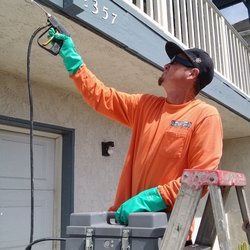Localized Treatment

Secondary Treatment Options For Termites
There are several alternative methods of localized termite spot treatments, transferable termiticides, residual termiticides, borate treatments, foaming penetrants, heat treatments, microwaves and electricity. In certain situations, such as controlling Subterranean termites, drilling and treating or rod and trench applications of repellent termiticide barriers are the only choice for continuing control. Depending on the application, there are two types of termiticides used for control, repellent and non-repellent termiticides. Repellent termiticides form a repellent barrier which prevents termites from entering the structure. Non repellent termiticides are non detectable to termites and rely on termite activity to eliminate infestations.
There are several secondary treatment options for Drywood termites. Non-repellent, transferable termiticides allow termites to penetrate treated areas where they contact the active termiticide. The termiticide is then carried on the termite’s body into the colony, spreading to other termites like a virus. Borate treatments and foaming penetrants soak into the wood members and leave behind residual termiticides, killing the termites. If you are interested in tent-less termite control, call Pest Innovations, our termite inspection specialists will be more than happy to explain secondary treatments for your structure.
Non Repellent Local Treatments
Non-repellent termiticides stop termite feeding within hours of exposure. The first termites to come into contact with the treatment are exposed through contact and ingestion and carry it to the colony on their bodies to affect other unexposed termites. Delayed toxicity means exposed termites that have stopped feeding can still walk, groom and aggregate in groups for an extended period of time, allowing treatment to further spread among colony members. Non-repellent termiticies controls termites in less than three months and provides long-lasting residual structural protection.


